Book contents
- Frontmatter
- Contents
- Notes on Hydrodynamics. III. On the Dynamical Equations
- On the constitution of the Luminiferous Ether
- On the Theory of certain Bands seen in the Spectrum
- Notes on Hydrodynamics. IV. Demonstration of a Fundamental Theorem
- On a difficulty in the Theory of Sound
- On the Formation of the Central Spot of Newton's Rings beyond the Critical Angle
- On some points in the Received Theory of Sound
- On the perfect Blackness of the Central Spot in Newton's Rings, and on the Verification of Fresnel's Formula for the intensities of Reflected and Reflacted Rays
- On Attractions, and on Clairaut's Theorem
- On the Variation of Gravity at the Surface of the Earth
- On a Mode of Measuring the Astigmatism of a Defective Eye
- On the Determination of the Wave Length corresponding with any Point of the Spectrum
- Discussion of a Differential Equation relating to the Breaking of Railway Bridges
- Notes on Hydrodynamics, VI. On Waves
- On the Dynamical Theory of Diffraction
- On the Numerical Calculation of a class of Definite Integrals and Infinite Series
- On the Mode of Disappearance of Newton's Rings in passing the Angle of Total Internal Reflection
- On Metallic Reflection
- On a Fictitious Displacement of Fringes of Interference
- On Haidinger's Brushes
- Index
On the Formation of the Central Spot of Newton's Rings beyond the Critical Angle
Published online by Cambridge University Press: 07 September 2010
- Frontmatter
- Contents
- Notes on Hydrodynamics. III. On the Dynamical Equations
- On the constitution of the Luminiferous Ether
- On the Theory of certain Bands seen in the Spectrum
- Notes on Hydrodynamics. IV. Demonstration of a Fundamental Theorem
- On a difficulty in the Theory of Sound
- On the Formation of the Central Spot of Newton's Rings beyond the Critical Angle
- On some points in the Received Theory of Sound
- On the perfect Blackness of the Central Spot in Newton's Rings, and on the Verification of Fresnel's Formula for the intensities of Reflected and Reflacted Rays
- On Attractions, and on Clairaut's Theorem
- On the Variation of Gravity at the Surface of the Earth
- On a Mode of Measuring the Astigmatism of a Defective Eye
- On the Determination of the Wave Length corresponding with any Point of the Spectrum
- Discussion of a Differential Equation relating to the Breaking of Railway Bridges
- Notes on Hydrodynamics, VI. On Waves
- On the Dynamical Theory of Diffraction
- On the Numerical Calculation of a class of Definite Integrals and Infinite Series
- On the Mode of Disappearance of Newton's Rings in passing the Angle of Total Internal Reflection
- On Metallic Reflection
- On a Fictitious Displacement of Fringes of Interference
- On Haidinger's Brushes
- Index
Summary
When Newton's Rings are formed between the under surface of a prism and the upper surface of a lens, or of another prism with a slightly convex face, there is no difficulty in increasing the angle of incidence on the under surface of the first prism till it exceeds the critical angle. On viewing the rings formed in this manner, it is found that they disappear on passing the critical angle, but that the central black spot remains. The most obvious way of accounting for the formation of the spot under these circumstances is, perhaps, to suppose that the forces which the material particles exert on the ether extend to a small, but sensible distance from the surface of a refracting medium; so that in the case under consideration the two pieces of glass are, in the immediate neighbourhood of the point of contact, as good as a single uninterrupted medium, and therefore no reflection takes place at the surfaces. This mode of explanation is however liable to one serious objection. So long as the angle of incidence falls short of the critical angle, the central spot is perfectly explained, along with the rest of the system of which it forms a part, by ordinary reflection and refraction. As the angle of incidence gradually increases, passing through the critical angle, the appearance of the central spot changes gradually, and but slightly.
- Type
- Chapter
- Information
- Mathematical and Physical Papers , pp. 56 - 81Publisher: Cambridge University PressPrint publication year: 2009First published in: 1883

